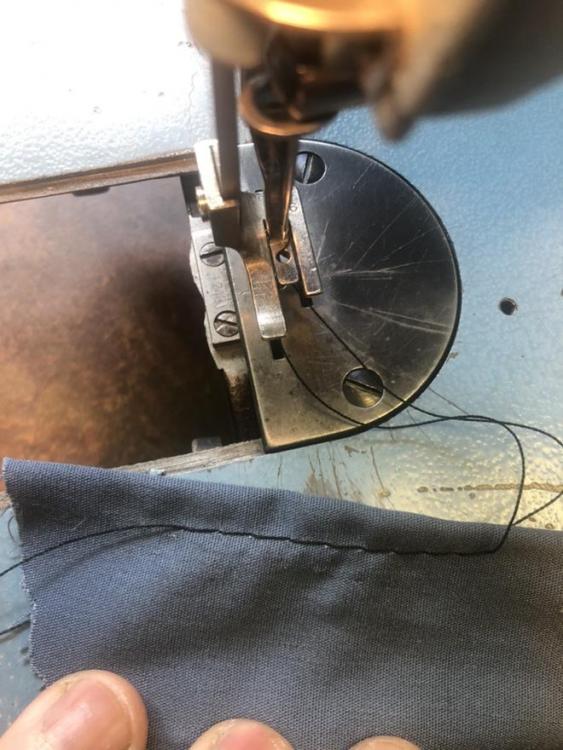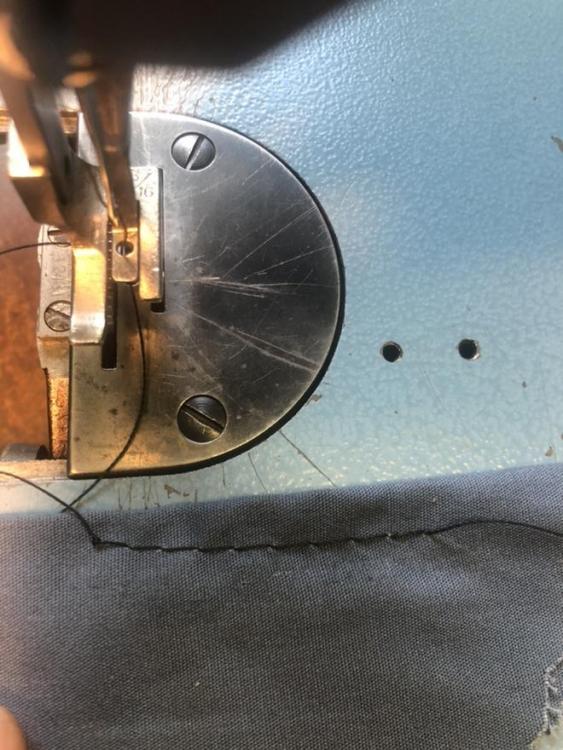-
Posts
14 -
Joined
-
Last visited
Recent Profile Visitors
795 profile views
Bj Dixon's Achievements

Member (2/4)
-

Singer 29 k large vs small bobbin capacities?
Bj Dixon replied to Bj Dixon's topic in Leather Sewing Machines
8.5 yds is plenty for what type of work I plan to do (personal stuff, not for pay). At least it's better than 4.25 yds in a small bobbin.... -

Singer 29 k large vs small bobbin capacities?
Bj Dixon replied to Bj Dixon's topic in Leather Sewing Machines
For me it's more about not running out before I'm finished something like a large holster, belt, gloves, etc. If I can double the bobbin size by choosing a different model at time of purchase, that at least gives me a better chance of finishing before the bobbin runs out..... -

Singer 29 k large vs small bobbin capacities?
Bj Dixon replied to Bj Dixon's topic in Leather Sewing Machines
Check. So the large bobbin is roughly twice the capacity of the small bobbin. Do you find the wider/deeper arm on the large bobbin machine limiting or are there any real functional difference between the two? -
I own neither of these machines, but i am in the market as it were. Is it worth shopping for a large bobbin machine over a small bobbin? If you could give me a frame of reference that would be great. For example: a small bobbin will hold 10 feet of 138 and a large bobbin will hold 15 feet. Or maybe compare it to a more common bobbin size like a 20U bobbin. I also see the large and small bobbin arms are slightly different sizes. Is there any significant disadvantage to the slightly wider/deeper arm end? Thanks for any replies.
-
Yep. Ordered a complete assembly. Whatever doesn't get used will go into the parts drawer. Never hurts to have spare parts around.....especially when all your machines are in the 55-60+ years age range. I think my newest is around 45 years old.......;)
-
quick test stitch. top: Bottom: It's far from perfect, but that was just to prove to myself it will at least make a stitch. I just grabbed a scrap of whatever was lying around, threaded up whatever came out of the drawer and just used whatever needle was in the clamp already. So not too bad, especially considering I was doing flat fabric with a piping foot on the machine (I have a flat/smooth foot on order). It grabs, just not very solidly or evenly. There's just not enough surface area between the presser and dogs to feed properly. So, now it's replace a couple tired old parts, a touch of fine tuning, and then it should be good to go. Whew, that was more of a fight than I ever wanted, but we're there!
-
Well, it's running and stitching now. But there's still a problem I need to chase down. The upper stitch is so loose, it's making big loops on the underside of the fabric. Normally you would just think a tension problem, crank it a bit more and good to go. But not this time. The tension disc is bottomed out on the thread and still making loops. So time to have a look at the tensioner, it does seem to pull throught a little too easily, even with the thumb nut all the way down. Hopefully it's just something simple like the spring has gone a little slack..... Edit: mystery solved. Need a new tensioner. I pulled the (what I'm assuming) off and gave the spring a good stretch. It;s only temporary as a spring that has lost it's "springyness"will always quickly collapse after being stretched, but it proved the point. The stitches are tighter now, but still not properly tensioned. No more big loops though, so I ordered a new tensioner assembly and (fingers crossed) that should be it....
-
My 331k105 is getting ready to start slinging thread again. But one of the things I'm noticing is the feed dog screws keep loosening off as it runs. There's just so much vibration there and no doubt the screw hole threads are a little "slack" after 50-odd years of sewing. I have thought of using a little locktight blue on them, but I'm a little concerned those cheap little singer common screw heads might not be up to the task of turning the screws back out again against the locktight. Anyone run across this problem before? what was your solution? I'm also getting a little fed up with these cheap, common screwdriver screws. I'm thinking about heading to the local bolt supply store and swapping out as many as I can for new hex drive pan heads (assuming they make them that small). I do that with a lot of my machinery, most notably Japanese bike carbs. They have JIS screws in them (look like phillips, but not) and they usually just strip when trying to remove them. Hex drive scews solve that problem and I'm thinking it might in this sewing machine as well. If nothing else, it woudl be a loteasier to install/remove them as opposed to the slotted heads. Anyone go down that route yet?
-
Well, I think I've got it and if it's what I think it was, I'm not really sure how the machine ran for the PO. I pretty much went "back to basics". First was to time the hook driver, then the hook itself. But I didn't time it to the needle (at first), I just made sure that once the hook had picked up the thread that it had enough rotation to hand it off and pull back up through the whole bobbin assembly. Once I got that sorted, the hook was obviously waaaay out of time with the needle. Well, to fix that, I had to loosen the set screws in the thread take up cam and re-time that. That gets the needle where it need to be in the cycle for thread pick up. Next up is to set the feed dog height and make sure the geometry is still good for the "walking foot" as messing with all those cams and adjustments has a direct bearing on how the walking foot moves during it's cycle. So far, it seems to be sorted. I have no doubt that there will be lots more fine tuning to do, but it seems I'm at least in the ballpark now. Strange thing is: the machine was at least running when I bought it and it went back together with all the witness marks lined up. I didn't see it make a stitch because it had a broken needle and she said it was out of time. If my witness marks would have been rotated 180 degrees, that would have made sense that I messed up and put it together 180 out somewhere. But some of the witness marks were out 90 degrees (or less). Perhaps it was out of time and breaking needles for the PO because someone had royally messed it up.....before I royally messed it up that is.....lol!
-
I would be interested in your "rattle fix" if you don't mind sharing? I was actually thinking of a hook driver swap of some type. I notice my newer oscillating hook machines have a "spring" on the driver that takes up the slack that's present in my 331k105 hook assembly....
-
Well, I'm stumped. I'm putting my Singer 331k105 back together after a clean and refurb. Everything was going fine and it's not that complicated a machine. I had photographed and witness marked everything I could and anything that would come out as an assembly, did. I knew adjustments would be off, but should have been in the ballpark, even if they are waaaaay out at the outside wall in left field.... I had the rotary hook assembly back together and timed fine. It was catching the needle thread and going to the bottom to thread it back up and around, catching the bobbin thread. But then, for no apparent reason, it started not spooling the thread around the bobbin/case to make the loop that catches the bobbin thread. I thought something might have shifted, but everything checked tight and secure. Ive checked everything for hooks/snags/burrs/dirt; nothing. I rechecked the timing and the needle bar heights: nothing, all checked good. I'm baffled. One thing I did notice is the hook doesn't seem to be rotating the same/amount as it did. It seems like it wants to goo to far to the rear (it will actually catch on the bobbin case spring screw where it's raised a little) and then it's like it is not rotating towards the front enough to "flip the thread". Singer manuals are useless, they don't go this deep into servicing/maintenance. There's no service manual for a 331k105, but there are some for the 331k's and the 31-19/47 models. But again, far too simplistic for what I seem to have going on here. They only address the tings someone may run into at home, like hook timing, etc. Any ideas on where I should look next? I'm almost out of ideas....
-
Well, after a couple hours of frigging with the clutch motor, I gave up and ordered a servo motor.I tried messing with the clutch, longer clutch arms, resistance under the pedal, etc. I could just about get it to slowly “thunk thunk”, but never reliably and I never knew when it was going to just grab and scream up to max rpm. Its just too finicky and unreliable, especially if I plan to do upholstery leather. oh well, at least I got to mess with it for a while. Maybe I can use that great big ac motor on a power tool somewhere....
-
That's encouraging, seeing as I plan to sew some upholstery leather with it....
-
Hello all. I've been around for a couple years, but mostly lurking and reading. I mostly work on textiles, webbing, vinyl and light leather. Primarily, I work in vinyl and leather for my motorcycle and car projects (ie: motorcycle seats, etc) and textiles are usually things like covers, tops, etc for Off road toys. I don't do anything like belts, harnesses, chaps or the like. It's all "lighter" stuff. I also usually end up doing clothing repairs and the like for my missus (she can't sew a stitch). It's all personal stuff, and maybe the occasional small things for friends and family. I've always used domestic machines, but the older ones. Things like a Singer 319W, etc. Mostly 50'-60's machines. I like the industrial look and the feel of an all metal machine. But they have their obvious limitations. I usually do the waxed paper trick if I have to pass leather or vinyl under the flat presser feet of these machines, but that's never ideal and you end up with lots of little pieces of waxed paper stuck in your material/stitches. I never really wanted to invest more into them than getting them looking decent and working right, so no roller feet, etc. I've been vetching for years for a walking foot machine, but they're nearly impossible to find here, I've seen a total of two up for sale in the last two years. One was a Pfaff, but the seller never responded to my inquiries and the other was a knock off of what looked like the smallest of the Sailright's (like a domestic sized machine). I've been watching ebay forever, but you're talking in the 2000-3000 range to get anything worth buying, ship it, duties, taxes, etc. I could pay that, but I just can't bring myself to spend that kind of money on something I might use a couple times a year (when not doing a project of some sort). A couple days ago, a singer 331k105 showed up on facebook marketplace and it was only 10 mins away. Here's the add pic: It's all there, it's just a little....ahem.....neglected. It's not really a "commercial" model, nor is it a "domestic" model. It seems kind of halfway between both worlds. I guess that's why they put "professional" on it: more than domestic, less than commercial, it needed it's own category....lol! I actually kind of like it that way, as I can still do domestic tasks on it yet have enough "punch" for entry level/light leather work. Straight stitch, no reverse. Not that big of a deal. Has a manual with it, but I don't think it's the original one. There was actually a bill of sale/warranty card in the drawer and it said it was sold in 1966 in Baden-Baden. The manual is for all 331k's, with a publication date of 1975. There was a parts list too, but it's for a 331k5. Still, lots of good info there and the orginal owner card was kind of neat to see (I was born in 65, which may very well be the birth year of this old rig). The lady that had it said she had it "tuned up" last year, but it was now out of timing. In a nutshell, the hook doesn't seem to be picking up the thread. She says she was sewing, broke a needle on some fabric and it's been out of time since. That doesn't worry me, I plan to pull it apart to the nuts and bolt and restore it. Information on it is pretty sparse on the web, I'm guessing because it's not common, like domestic (or more mainstream) machines. I'm aware that it is intended as a tailor/seamstress machine. It's got a walking foot, but it's not the compound feed. It's the hopping/vibrating/kick/hobble foot. Basically, the dogs pull back the outer foot and then it springs back when the feed dogs drop. So it's got it's limitations, but it will do what I need it to do: light leather and vinyl work. Parts are a little hard to come by it seems. It appears (from what I have read) that it has a lot in common with machines like the 331k5 and I've read a couple posts that indicate it's basically a 31 series in a different body. The kick foot 31's seem to be serials like 31-47. Anyone know if parts from those machines will fit my 331k105? Or other machines that may have the same parts? When I got it home, I started pulling it down. They were smokers and man it shows. Took about an hour with cleaners and a toothbrush just to get most of the baked on tar loose. And that was just the exterior. I ran a little Neverdull over the brass bits and they start to clean up nicely. that's a good sign for later when I actually clean/polish/buff them back to new. The body is decent, but I'm probably going to have to strip it down to bare metal to deal with some light rusting and what not. Probably go back to the same "robin's egg blue" color. The names (Ie:Singer,Professional, etc) I'll photograph and have replicated in vinyl stick on lettering. Would be nice to save the original painted letters, but if I strip it down that's not an option. I plan on dropping all the bits and whatnot into the ultrasonic, which will take care of the 50+ years of crud baked into this thing everywhere. First was a quick overview/check. Well, it's not feeding material. A quick look reveals the feed dogs are loose. Tighten that up and it now wants to just spin the material under the foot. I also notice that the "walking foot" doesn't "walk" all the way back to the point where the dogs drop. A little cleaning, positioning and work on presser pressure gets it moving. A bit more adjusting and it "mostly" feeds now, it just has a slight tendency to pull the fabric to the right. I pull the foot off and flip it over. Ah, there it is: it's a piping foot and a large one. there's almost noting contacting the dogs. No flat presser in the box of bits, so I order one up. Sheesh, there goes 80 bucks! (exchange, shipping, etc) But I have no choice, I can only find it one place online. Well, 2 places, but one of those is ebay and it's the guy who is selling them on his own website. Stitch length is a little short for leather. It is only spec'd for 4.5 mm. Well, I'd like a longer stitch length than that, so i start digging around. I discover that if I remove the nice decorative plate around the stitch length lever, the lever drops down further. I try out a stitch on some paper and it measures out to 6.5 mm. Not bad, not bad at all, considering it started closer to 4 mm. I may try a little filing on the case to see if I can gain another .5 mm without messing up the machine. 7 mm would be a decent length for exposed stitches on leather. It's got a clutch motor, which is obviously not ideal for me. It runs like a tailoring machine right now, meaning it's g-d frighteningly fast as soon as you even graze the pedal! I'll play around with it a little bit (longer arm, pulleys, etc) since I already have it and it costs me nothing to mess with it, but I'm thinking I'm just going to end up ordering a servo motor. It's not even an original motor, it's a 1/2 horse Consew motor. The clutch motor will do for now, as I'm just going to be tearing it apart and need the motor to confirm function when I get it back together. It should be a fun learning experience messing around with the clutch motor, even if it eventually ends up on a shelf somewhere..... I'll have to see how that "hopping foot" deals with some leather/vinyl. If it's not working out, I may switch to a roller foot and see how that goes. I'm sure I'll find no end of modifications and substitutions that will fit the ol' girl. Should be a fun little project and hopefully, it will fit my needs. Any info, suggestions or links to info/manuals appreciated!






